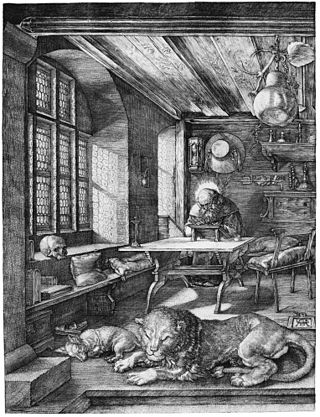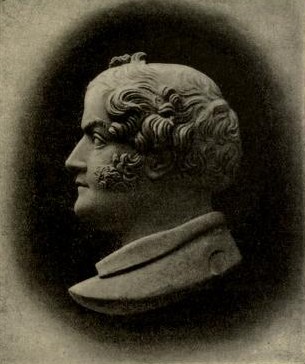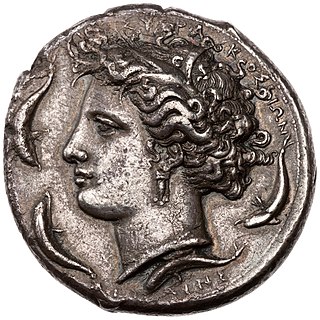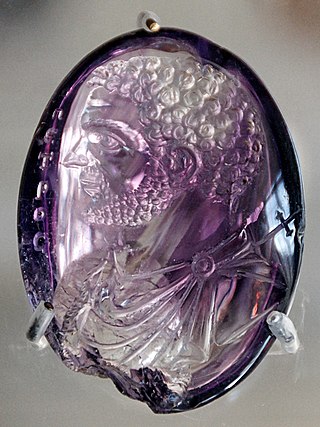
A coin is a small object, usually round and flat, used primarily as a medium of exchange or legal tender. They are standardized in weight, and produced in large quantities at a mint in order to facilitate trade. They are most often issued by a government. Coins often have images, numerals, or text on them. The faces of coins or medals are sometimes called the obverse and the reverse, referring to the front and back sides, respectively. The obverse of a coin is commonly called heads, because it often depicts the head of a prominent person, and the reverse is known as tails.

Numismatics is the study or collection of currency, including coins, tokens, paper money, medals and related objects.

Engraving is the practice of incising a design onto a hard, usually flat surface by cutting grooves into it with a burin. The result may be a decorated object in itself, as when silver, gold, steel, or glass are engraved, or may provide an intaglio printing plate, of copper or another metal, for printing images on paper as prints or illustrations; these images are also called "engravings". Engraving is one of the oldest and most important techniques in printmaking.

Benedetto Pistrucci was an Italian gem-engraver, medallist and coin engraver, probably best known for his Saint George and the Dragon design for the British sovereign coin. Pistrucci was commissioned by the British government to create the large Waterloo Medal, a project which took him thirty years to complete.
Thomas Wyon the Younger was an English medallist and chief engraver at the Royal Mint.

A medalist is an artist who designs medals, plaquettes, badges, metal medallions, coins and similar small works in relief in metal. Historically, medalists were typically also involved in producing their designs, and were usually either sculptors or goldsmiths by background. In modern times, medalists are mostly primarily sculptors of larger works, but in the past the number of medals and coins produced were sufficient to support specialists who spent most of their career producing them. From the 19th century, the education of a medalist often began with time as an engraver, or a formal education in an academy, particularly modeling and portraiture. On coins, a mark or symbol signifying the medalist as the original designer was often included in a hidden location and is not to be mistaken for the symbol of the mint master. Artistic medals and plaquettes are often signed prominently by the artist.
This glossary of numismatics is a list of definitions of terms and concepts relevant to numismatics and coin collecting, as well as sub-fields and related disciplines, with concise explanations for the beginner or professional.

In Greek mythology, Arethusa was a nymph who fled from her home in Arcadia beneath the sea and came up as a fresh water fountain on the island of Ortygia in Syracuse, Sicily.

An engraved gem, frequently referred to as an intaglio, is a small and usually semi-precious gemstone that has been carved, in the Western tradition normally with images or inscriptions only on one face. The engraving of gemstones was a major luxury art form in the Ancient world, and an important one in some later periods.

Pyrgoteles was one of the most celebrated gem-engravers of ancient Greece, living in the latter half of the 4th century BC. The esteem in which he was held may be inferred from an edict of Alexander the Great, which placed him on a level with Apelles and Lysippos, by naming him as the only artist who was permitted to engrave signet rings for the king.

Philistis, the wife of Hieron II, was a queen of ancient Syracuse, known only from her coins, which are numerous, and of fine workmanship, and from the occurrence of her name in an inscription in large letters on the great theatre of Syracuse. The circumstance that it is here associated with that of Nereis, the wife of Gelon II, as well as the style and fabric of the coins, which closely resemble those of Hieron II and his son, leads to the conclusion that these were struck during the long reign of Hieron II. The most probable conjecture is that Philistis was the wife of Hieron himself.
The gens Titia was a plebeian family at ancient Rome. The gens is rarely mentioned in the Republican period, and did not rise out of obscurity till a very late time. None of its members obtained the consulship under the Republic, and the first person of the name who held this office was Marcus Titius in BC 31.

Alfred Robert Freebairn (1794–1846), was an English engraver.

Louis-Eugène Mouchon was a French painter, graphic artist, medalist, engraver and sculptor. He created state papers, stamps, coins, currency and medals. He was the son and pupil of Louis Claude Mouchon, the painter. He exhibited at the Salon from 1876 onwards and became an Associate of the Artistes Francais in 1888. His most famous stamps are the Mouchon series and the Navigation & Commerce series of French postage stamps. His medals can be found in the collection of several museums.

Johann Lorenz Natter (1705–1763) was a German gem-engraver and medallist.

Ancient Greek art stands out among that of other ancient cultures for its development of naturalistic but idealized depictions of the human body, in which largely nude male figures were generally the focus of innovation. The rate of stylistic development between about 750 and 300 BC was remarkable by ancient standards, and in surviving works is best seen in sculpture. There were important innovations in painting, which have to be essentially reconstructed due to the lack of original survivals of quality, other than the distinct field of painted pottery.

Joséphine Calamatta was a French painter and engraver who painted portraits as well as symbolistic, religious and allegorical pictures.
The gens Rupilia, occasionally written Rupillia, was a minor plebeian family at ancient Rome. Members of this gens are first mentioned in the latter part of the Republic, and Publius Rupilius obtained the consulship in 132 BC. Few others achieved any prominence, but the name occurs once or twice in the consular fasti under the Empire. The name is frequently confounded with the similar Rutilius.

Christian Fueter was a Swiss medalist and mint-master at Bern from 1792–1837.
The gens Stallia was an obscure plebeian family at ancient Rome. Hardly any members of this gens are mentioned by ancient writers, but a number are known from inscriptions.















